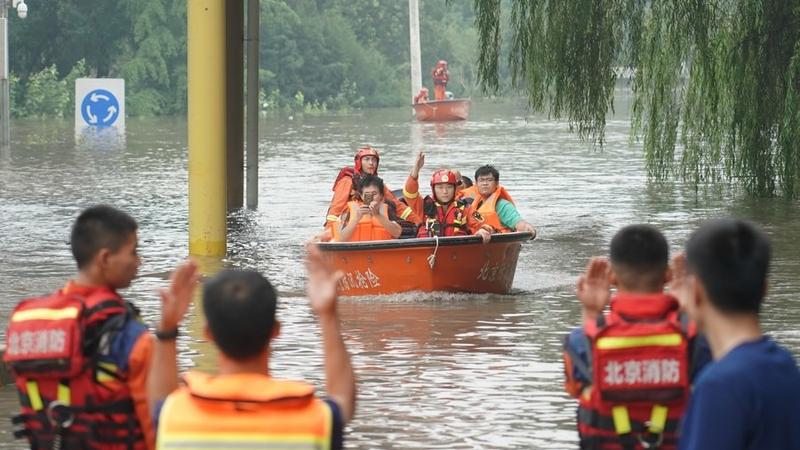Extreme weather events pose increased challenges
 (SONG CHEN / CHINA DAILY)
(SONG CHEN / CHINA DAILY)
The word "extreme" is a leading candidate to best describe summer in China this year, when an average temperature of 22 C was experienced, the second highest recorded in the country since 1961.
While there was also limited rainfall nationwide, with drought affecting some northwestern areas, Beijing witnessed its heaviest downpours since 2012.
In recent years, extremely hot summers in China have been followed by bitter winters, so the big question is whether the coming months will be exceptionally cold.
Winters and summers have become longer at the expense of spring and autumn. Unless humanity can reverse carbon emissions, there is little hope of solving this problem.
Liu Hongzhi, deputy head and secretary-general of the International Ecological Economy Promotion Association
Zhu Dingzhen, a retired chief expert at the China Meteorological Administration's Public Meteorological Service Center, said it is hard to give a definite answer, but there is a high probability that this winter will be a tough one.
"There is no direct link between temperatures in summer and in winter, but when the former are extremely high, it is a sign that the entire climate system is turbulent, meaning there is a much higher possibility of the latter being extremely low," Zhu said.
Zhu stressed that extreme cold is a "concept" of weather rather than climate, and refers to single-day temperatures rather than the average temperature for a whole season.
A good example is 2021, when China had a warm winter, but Beijing experienced its lowest recorded single-day temperature.
"A warm winter doesn't mean it is warm every day. With climate change intensifying, there might be relatively frequent spells of cold weather during warm winters, so we must always be prepared," Zhu said.
Chen Wei, an associate researcher at the Chinese Academy of Sciences' Institute of Atmospheric Physics, said that as air pressure near the ground is higher in hot regions than in polar areas, a constant air flow from the former to the latter develops into westerly winds in middle latitudes of the northern hemisphere.
"A so-called protective wall is formed, turning any cold wave from the north into westerly winds, thus preventing it from heading further south," Chen said.
However, due to climate change, temperatures in the Arctic region are rising, narrowing the gap with those on the equator.
Chen said that as a result, westerly winds become weaker in middle-latitude regions, preventing cold waves going south. Combined with the increasingly unstable polar vortex that unleashes more cold waves, the frequency of cold weather naturally increases.
"That's why extremely cold days can appear in warm winters," Chen said.
In a worst-case scenario, the process can become a vicious circle. The huge piles of ice in the Arctic act like a large mirror, reflecting solar rays back into space, but as the ice melts, the reflection weakens, so more heat accumulates, accelerating the meltdown process. This in turn further weakens the reflection.
Chen said the academic term for this process is the "Arctic amplifying effect", which has already begun and will not be reversed until efforts are made to significantly slow global warming.
Severe flooding
A report released early last month by the China Meteorological Administration stated: "Heavy rainfall has become more frequent, causing severe flooding in North and Northeast China, resulting in 'U-turns' between drought and flooding.
"Typhoons are few in number but more destructive in force, with Typhoon Doksuri causing heavy flooding. There have been more days with high temperatures, some of which have been extreme. Catastrophes such as short-term strong rainfall, lightning storms and hurricanes have been reported more widely."
While for urban residents the term "weather catastrophe" may result in disrupted travel arrangements or having to stay at home, for agricultural production, it means actual losses.
Wang Qingxue, 60, a farmer from Shandong province, said: "A cold wave is enough to kill all the seedlings in a field. That's why we farmers are really afraid of drops in temperature in autumn and spring. Humans just need to put on more clothing, but crops obviously cannot do so. In recent decades, we have grown more seedlings in greenhouses."
Wang Ke, deputy dean of Renmin University of China's Institute of Ecological Civilization, said humans face greater challenges to their health in extreme cold and heat. Some outdoor construction and engineering projects also have to be suspended or operated at lower efficiency, while crops might wither in cold weather or die in heat, thus posing a bigger risk to national food security.
Cities either have to face losses during flooding or raise construction standards to cope with such incidents, which come at a huge financial cost.
On Aug 9, the Beijing municipal government said that during flooding in the city this summer, 33 people died and 18 went missing. A total of 1.29 million people were affected by the floods, 59,000 rooms collapsed, 147,000 rooms were damaged, and 150 square kilometers of agricultural land was left underwater.
In September last year, a report by Oxford University estimated that the world might face losses of $23 trillion due to climate change by 2050. In comparison, China's GDP last year was $18 trillion.
Skeptics have long questioned whether the planet is experiencing climate change. Some articles have even gone viral with headlines such as "10 benefits of global warming", claiming that with global warming, some tropical or sub-tropical fruit could be planted in northern regions, while dry northwestern regions would become wet.
Chen said this is possible because more vapor could develop in areas with higher temperatures, increasing uncertainties about global rainfall.
"It's possible that regions that used to be dry could become wet, but the cost would be too high for humankind to bear," she said.
Chen added that the amount of new rainfall in dry regions, if there is any, would be limited. Only a relatively small proportion of vapor can be carried from oceans to inland areas, and during this process a large amount of vapor dissipates.
If there is enough rainfall in inland regions to turn deserts green, this would mean humans could no longer survive in coastal regions, Chen added.
Zhu, from the China Meteorological Administration, said only part of the flooding in the past decade was the result of increased rainfall. The majority came from melting glaciers on the Tianshan Mountains in Xinjiang Uygur autonomous region.
"Glaciers are the most important water storage for humankind. If they melt more quickly, naturally our water resources will be exhausted more rapidly," he said.
Yang Yong, who launched the 2015 World Water Source Summit in Yushu city, Qinghai province, visited the sources of several major rivers, including the Yangtze, in summer last year, a typically wet season. He saw large parts of the river banks covered by sand. The Yangtze, the Yarlung Zangbo River and the Indus River in India all experienced this problem.
In April 2017, the Tianshan Mountains Glacier Observatory found that two areas of the No 1 glacier had retreated by 6.3 meters and 7.2 meters, with the western branch experiencing its biggest retreat since it formed in 1993.
 People take a rescue boat to a transshipment point in Fangshan District of Beijing, capital of China, Aug 2, 2023. (PHOTO / XINHUA)
People take a rescue boat to a transshipment point in Fangshan District of Beijing, capital of China, Aug 2, 2023. (PHOTO / XINHUA)
Common cause
All these extremes point to a common cause of climate change. Throughout the 20th century, the Earth's average air temperature rose by 0.6 C due to the accumulated effects of carbon emissions for the past few centuries, which were sufficient to raise summer temperatures and lower those in winter by record levels.
It is hard to imagine what would happen if global temperatures rose by 2 C, the limit set by the Copenhagen Climate Change Conference in 2009 and underlined further by the Paris Climate Conference in 2015. Also, some key clauses of the Paris Agreement, such as that referring to nationally determined contributions, are voluntary, instead of legally binding, meaning that participants have the choice to implement it or not.
On Sept 8, a technical report published on the United Nations Framework Convention on Climate Change website said that despite global efforts in the past seven years to cut carbon emissions and meet the most basic 1.5 C goal by 2030, the world is still missing the emissions goal by 20.3 billion to 23.9 billion metric tons of carbon dioxide equivalent.
"Global emissions are not in line with modeled global mitigation pathways consistent with the temperature goal of the Paris Agreement, and there is a rapidly narrowing window to raise ambition and implement existing commitments in order to limit warming to 1.5 C above pre-industrial levels," the report said.
Liu Hongzhi, deputy head and secretary-general of the International Ecological Economy Promotion Association, which is based in Beijing, said the damage caused to health by extreme weather is beyond general expectations. Researchers affiliated with the association have long found that extremely high and low temperatures can increase the risk and death rate from cardiovascular diseases. Temperatures of more than 32 C are extremely bad for those with such diseases.
"That's why when winter or summer arrives, we call for seniors to take precautions," Liu said. "But winters and summers have become longer at the expense of spring and autumn. Unless humanity can reverse carbon emissions, there is little hope of solving this problem."
The G20 New Delhi Leaders' Declaration, published on Sept 10, vowed to "pursue low-greenhouse gas/low-carbon emissions, and climate-resilient and environmentally sustainable development pathways by championing an integrated and inclusive approach."
All the experts interviewed for this article called for more concrete steps to support this declaration and turn a dream into reality.
Wang, from Renmin University, said, "Climate radicalization is not gradual, and we cannot expect a long, comfortable process to adapt to changes."
He cited this summer as an example, as temperatures in Beijing alone exceeded 35 C on 29 days, compared with an average of 21 days from 1960 to last year. Worse still, temperatures in the capital exceeded 40 C on five days.
Questions are already being asked about the number of days on which temperatures will rise above 40 C next summer, and the amount of time that humankind has to deal with this urgent problem.


